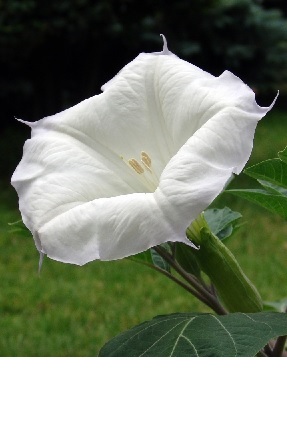 Sacred Datura - February 11, 2015 Jeff Schalau, Agent, Agriculture & Natural Resources University of Arizona Cooperative Extension, Yavapai County Sacred datura (Datura wrightii) is a large, sprawling, native perennial that grows throughout the Verde Valley (and across Arizona between 1,000 and 7,000 feet elevation). It is a member of the family Solanaceae making it a relative of the tomato, potato, pepper, and eggplant. Other common names include: Jimson weed, thorn apple, Indian apple, moon lily, moon flower, angel's trumpet, and tolguacha. In the wild, sacred datura is found on well-drained, sandy soils in arroyos, washes, on roadsides, and other areas that have periodic disturbance. It is often considered a weed. However, it can easily be incorporated into a drought tolerant landscape with great effect. When considering its use in the landscape, remember that all parts of the plant are deadly poison. In practicality, sacred datura is not often accidentally consumed by humans or animals. All plant parts (except the flowers) have a very repellent smell and are extremely bitter. This makes deliberate ingestion very unlikely, even by small children. Deliberate consumption is most often linked to adolescents looking for a mind-altering experience. Sadly, death can be the result. Those that survive often have permanently damaged lungs, stomach, intestines, kidneys, and/or heart. This may also be accompanied by mental impairment. These side effects are a high price to pay for a fleeting psychedelic experience. Now let’s look at the positive aspects of sacred datura. The leaves are medium green on top and gray-green on the underside, have smooth margins, and alternately arranged on stout stems. Individual plants often grow 2-3 feet high and sprawl 6-8 feet across. During the summer months, sacred datura produces dozens of large, fragrant, white, trumpet-shaped flowers. These are often 6-8 inches in diameter, have five slender teeth at their margins, bloom in the early evening, and close by noon of the following day. Seedpods are globe-shaped and very spiny. These split open when ripe to release several, semicircular, flattened, yellow-brown seeds. Night-blooming plants must be pollinated by nocturnal visitors. Sacred datura flowers are pollinated by sphinx or hawk moths. These evening visitors can be seen feeding on the nectar of newly opened flowers. They are often mistaken for hummingbirds as they produce a soft "whir" or "buzz" and hover as they feed. They have a long proboscis that unfurls to reach into the nectary at the base of the bloom. As they do so, they inadvertently assist in pollinating the flowers they visit. Datura can be planted near a patio where the fragrance and moth activity can both be enjoyed on warm summer evenings. Sacred datura dies back to the ground following winter freezes. The plant has a fleshy, tuberous root, which resprouts with the return of warm weather. Although I have never propagated it myself, I would encourage interested gardeners to try growing it from seed. Collect seeds from dried pods in the fall. Before planting, I would suggest nicking them with a file or pocketknife and planting them 5 to a one-gallon pot filled with a sandy soil media in spring (after frost danger is past or with frost protection). If more than one seed germinates, thin out all but one seedling. Allow it to grow until the roots have spread throughout the pot and transplant into a well-drained location during the growing season. Water it intermittently until established during the first year. The following year it should be able to make it on native rainfall. You may spur its growth with supplemental irrigation, but its form and flowering may be adversely affected by excess irrigation. A bit of folklore: the name "Jimson weed" is said to have originated form the presence of a similar species in Jamestown, Virginia. The name "Jamestown" was corrupted to "Jimson" at some point in time. Early colonists were said to exhibit strange behavior and illness after consuming it when other foods were not available. Sacred datura has a definite place in our native landscape. If you are like me, and are trying to encourage a natural look in your managed landscape, then try sacred datura. Don't forget to thoroughly wash your hands with soap and water after handling sacred datura plant parts or seeds. Below I have included links to photos/information on sacred datura and sphinx moths. Follow the Backyard Gardener on Twitter – use the link on the BYG website. If you have other gardening questions, call the Master Gardener help line in the Camp Verde office at 928-554-8999 Ext. 3 or e-mail us at verdevalleymg@gmail.com and be sure to include your name, address and phone number. Find past Backyard Gardener columns or provide feedback at the Backyard Gardener web site: http://cals.arizona.edu/yavapai/anr/hort/byg/. Additional Resources Datura wrighttii Yavapai County Native & Naturalized Plant Database, University of Arizona Cooperative Extension, Yavapai County cals.arizona.edu/yavapaiplants/SpeciesDetailForb.php?genus=Datura&species=wrightii Moths of Southeastern Arizona – Sphinx and Hawk Moths Dr. Bruce Walsh, University of Arizona Department of Ecology and Evolutionary Biology nitro.biosci.arizona.edu/zeeb/butterflies/Sphynx.html |